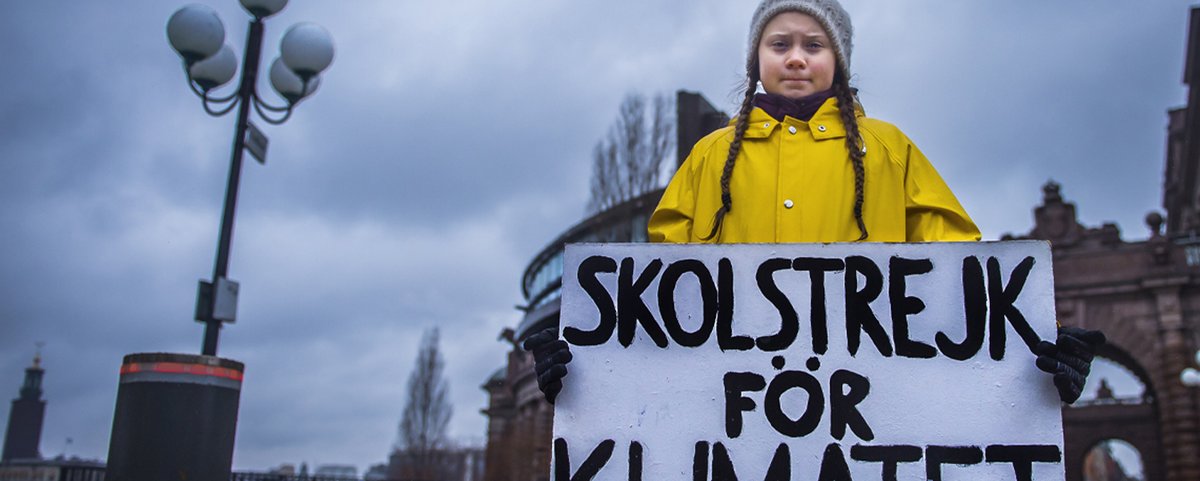Against all odds, environmentalist Greta Thunberg has succeeded in becoming a political icon. Professor of political science Thomas Olesen from Aarhus BSS has analysed how this was possible.
10.06.2021 | INGRID MARIE FOSSUM
Fridays for Future is one of the largest social movements ever. It started quite small with Greta Thunberg’s solitary school strike in front of the Swedish Parliament in August 2018. A lone child pitted against the adults, a child versus the system. But Greta Thunberg’s very first tweet spread rapidly and with it, the phenomenon took on a global presence. One single child in Sweden soon became six million protesting children across the world.
Breaking through the barrier like this, achieving this much impact and becoming a political icon – that only happens for a few people. How could it happen for Greta Thunberg?
“I have previously conducted research into political icons such as Nelson Mandela and Edward Snowden, examining why some people rise to special status and become icons. But Greta Thunberg – it is remarkable how she was able to achieve the status, she has today, considering her seemingly weak starting point lacking resources, being a child and carrying a load of mental challenges. It is a paradox,” says professor of political science Thomas Olesen from Aarhus BSS, Aarhus University.
He is the first person to conduct a scholarly analysis of the role social media play in creating a political icon. Greta Thunberg was an obvious case, seeing as she is one of the first political icons to be fully shaped in the new reality of social media. The analysis can be found in the article “Greta Thunberg’s iconicity: Performance and co-performance in the social media ecology,” published in the scientific journal New Media & Society.
“I became interested in what happens to the iconisation process in light of the new media, which enable a completely different type of interaction between the icon and its audience. Greta Thunberg is a product of the new media reality. How did she become an icon? How do social media help shape the iconisation process?” Thomas Olesen asks.
A great performance combined with social media
Social media have played a major part, but they did not create the icon Greta Thunberg single-handedly. You have to perform as well. At the same time, Greta Thunberg’s performance cannot be separated from the media environment in which it takes place. They interplay, and according to Thomas Olesen, it is hard to imagine the iconisation unfolding this way and to this extent without social media.
Thomas Olesen points to a handful of social media aspects which affect the course of the iconisation process. They reduce the cost of communication, emphasise visual representation, sustain intimacy between icon and audience, include a new and younger audience, and distribute communication across different media platforms.
With social media, you are not dependent on a large organisation backed by political or financial resources. Anyone can start a project and reach a relatively large audience with few means. Greta Thunberg succeeded in achieving a strong impact with very limited resources.
“The national election in Sweden presented a moment of opportunity by drawing attention to the climate issue, and she seized that opportunity to some extent. By primarily investing her own small body and with her homemade sign “School strike for the climate” (Skolstrejk för klimatet), she raised awareness. In the beginning, her activism was low-cost and low-intensive,” says Thomas Olesen.
Her message is nice and simple. ”We children rarely do what you tell us to do, we do as you do. And since you grown-ups don’t give a damn about my future, neither will I. I school strike for the climate until election day,” Greta Thunberg wrote on Twitter and posted a photo of herself in front of the Swedish Parliament.
Someone responded quickly, asking whether they were allowed to come strike with her. Absolutely, said Greta. It is easy to mimic her activism. The school strike can be carried out everywhere, e.g. in front of the local city hall, and it is not limited to one particular country. Gradually, more and more people went on strike with her.
Unlike traditional media, social media enable you to take control of your own performance. You decide what you want to say, what photo you want to post and on which channels. Some such as Facebook are well-suited for a debate, others such as Instagram are well-suited for photos. A common feature of social media is their capacity for interacting, mobilising, inspiring and mimicking.

"The raincoat becomes a part of the iconic personality because the audience makes it so, embracing the raincoat and superposing it on Greta as an icon
Thomas Olesen, Professor, Department of Political Science Aarhus BSS at Aarhus University
Interplay between traditional and social media
But you cannot start a movement this large by means of social media alone. Typically, it will also require traditional media – TV, radio and newspapers – to take an interest in the subject and help spread it.
“We know this from Donald Trump. Twitter has played a pivotal role in building his political status. His extreme political language has reached established media through Twitter. Lots of articles are structured around his tweets, and being an extreme figure on social media has provided him with coverage in traditional media. This is all part of his media strategy,” Thomas Olesen says.
Unlike Trump, Greta Thunberg has had no strategy in place and no expectation of her activism turning into one of the largest social movements ever. However, traditional media picked up on her activism on social media and eventually played an important part in spreading her message. But not until after she had raised awareness on Twitter.
The incredible story ends with this lone pupil fostering a global movement, with highlights counting Greta Thunberg’s speech to world leaders at the UN and the World Economic Forum, two front pages in Time Magazine and a nomination for the Nobel Peace Prize.
Transforming weaknesses to strengths
“It is obvious that in the beginning, all odds were against Greta Thunberg becoming an icon. In general, children do not possess the resources, impact and clout necessary to attain this status,” says Thomas Olesen.
Moreover, Greta Thunberg does not actually want to be an activist and is very conscious of her disinclination, but also of the need to step in and take responsibility in the face of adult passivity.
However, being a child is not merely a disadvantage when the audience consists of children and young people. She employs her identity as a child in a political context and gains a voice by way of social media. This makes it possible for her political communication to reach new generations. This is also the reason why social media have become an important component in the media strategy of Mette Frederiksen and other politicians. Whereas news displayed on television and in newspapers primarily cater to adults, Facebook enables you to reach a younger audience.
Something at stake
Like in the case of other political icons such as Nelson Mandela, Martin Luther King and Mahatma Gandhi, Greta Thunberg has also thrust herself against an ‘opponent’ much stronger than her: political decision-makers and other powerful people.
“Part of the power of an icon comes from the courage to step forward and take a considerable risk. Some risk death and incarceration. Living in democratic Sweden, Greta Thunberg does not risk her life, but she does put her childhood and schooling on the line. She does offer a sacrifice, as characteristic of those we elevate to iconic status,” says Thomas Olesen. He continues:
“She has acted with conviction. The candour of her concern for the climate, her anger and the emotions she wears on her sleeve – they all demonstrate that she is serious in her words and actions. This is definitely one of the reasons why she has achieved such impact, especially with the new audience present on social media. She appears very direct and without ulterior motives.”
So far, Fridays for Future has arranged 108,000 strikes in 7,500 cities and across 228 countries. In a survey, 40% of strikers name Greta Thunberg as their main source of inspiration.
Interplay with her followers
The iconisation of Greta Thunberg has occurred in an interplay with social media users as her co-performers.
“Previously, attributing emotions and meaning to iconic personalities was the prerogative of established media figures such as journalists and editors. Today, social media users have much greater say in the negotiation of the icon’s identity, and the visuals are a big part of this,” says Thomas Olesen.
The frail, innocent child Greta Thunberg with her braided hair, yellow raincoat and homemade sign, sitting beneath the massive stone walls of the Swedish Parliament, became a symbol of the child versus the large-scale system. The first photographs of the scene exposed this contrast visually, suiting the narrative of the heroic protagonist. In the commentary track on social media posts, the audience describes Greta as ‘good’, ‘sweet’ and a ‘hero’, thus demonstrating an emotional involvement in the creation of her iconicity. Greta Thunberg has become the very embodiment of the struggle against climate change. Now, she is merchandise, murals etc., and her followers have paid special attention to her practical yellow raincoat and turned it into a recurring symbol.
“The yellow raincoat is a visually poignant symbol. It has a strong colour, might evoke Nordic connotations and is mostly something you associate with children. Her iconicity is an interplay between what she does and how her audience reacts to it. The raincoat becomes a part of the iconic personality because the audience makes it so, embracing the raincoat and superposing it on Greta as an icon,” says Thomas Olesen.
By being open about her background and the challenges she faces in the form of Asperger’s syndrome, eating disorders and bullying, Greta herself invites a certain intimacy with her followers. You can read about Greta Thunberg’s personal experiences, respond to her, and talk about them with other users in the commentary track.
Greta Thunberg has demonstrated that even in the face of substantial personal struggles, it is possible to make an impact. ‘No one is too small to make a difference’, which is also the title of her book. Social media make it easier to communicate with a large audience and raise awareness, but the creation of iconic resonance is very much still dependent on the actions and personal qualities of the protagonist.
